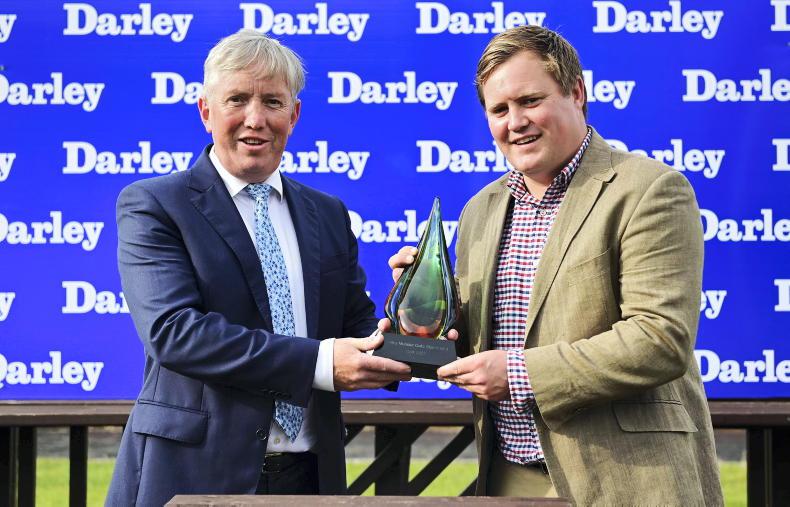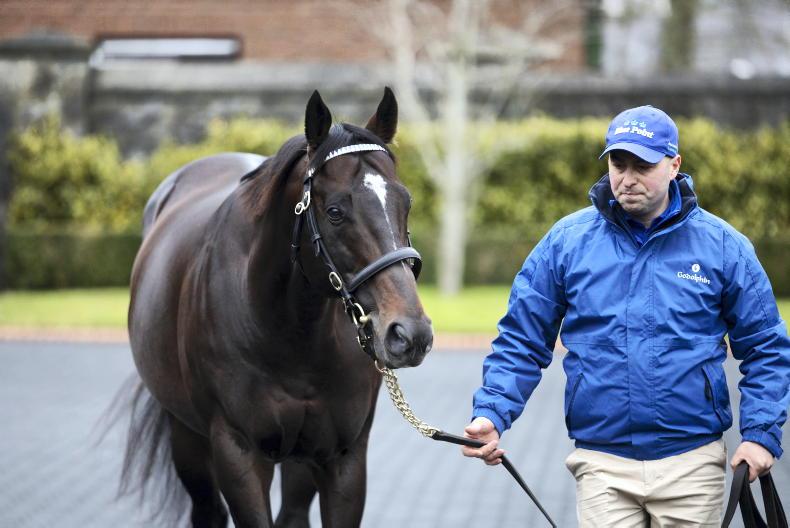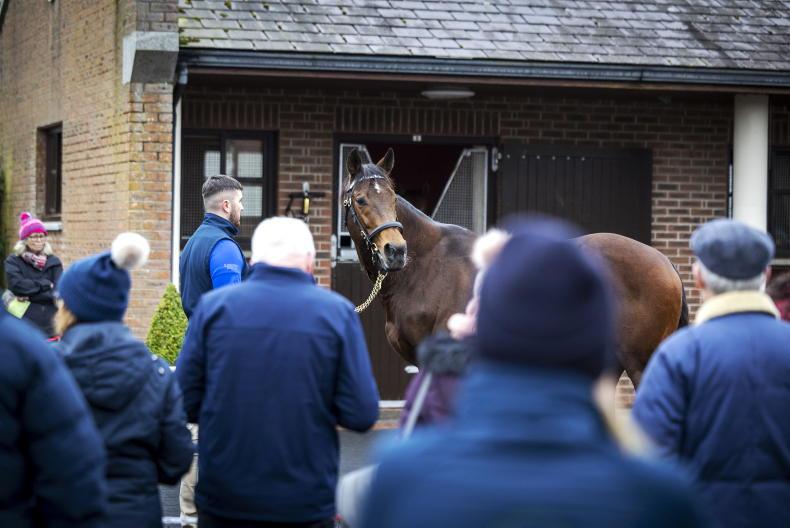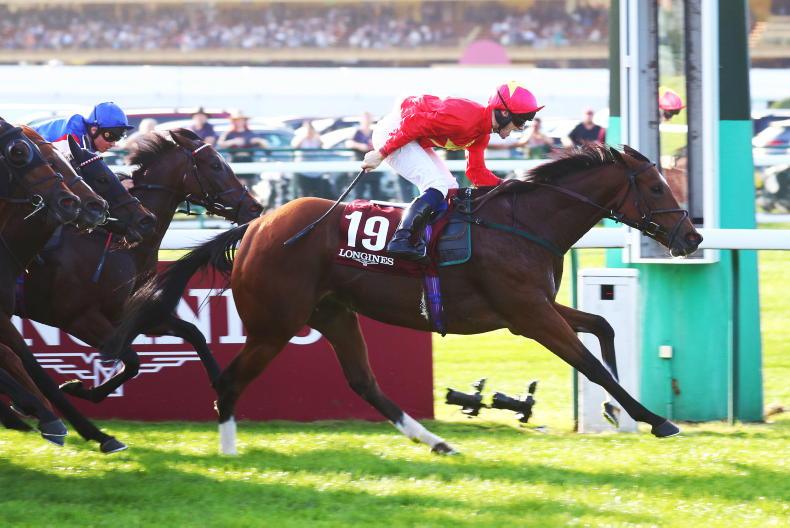JURGEN Klopp has admitted to running short on energy after an eight-year spell at the Anfield helm, but the same cannot be said after more than a quarter century at Kildangan Stud for the operation’s nominations manager Eamon Moloney. There are no signs of stopping at the Co Kildare base in this key window of the breeding season.
Much like Liverpool are flying high at the top of their division with a team of world-class players, the squad of star-name stallions under the Darley banner in Ireland right now have all the hallmarks of being equally prolific.
Blue Point did his best Mo Salah impression as a first-season sire last year, shooting the lights out by delivering an array of top-quality juveniles, while Night Of Thunder got on the Group 1 scoresheet again with Prix de l’Abbaye heroine Highfield Princess. Teofilo too had a campaign to remember, represented strongly by the likes of Melbourne Cup hero Without A Fight and globetrotter Nations Pride.
It is arguably Kildangan’s youngest players, however, who bring the most excitement to proceedings.
Ghaiyyath, formerly the world’s highest-rated racehorse, has his first two-year-olds hitting the track this season, and the same awaits Prix Morny and Middle Park scorer Earthlight, whose first yearlings sold for 325,000gns, 310,000gns, 260,000gns and €300,000 last year.
Triple Group 1 winner Space Blues’ first crop are now yearlings, Platinum Jubilee Stakes winner Naval Crown, described as the “fastest son of Dubawi”, joined the Monasterevin base last season, and classic-winning champion two-year-old Native Trail is new for 2024.
Could this be considered as exciting a group of stallions that has ever been assembled at Kildangan?
“For sure,” comes the reply from Eamon Moloney.
“The roster is in a very strong position, and that’s not just us thinking that. People are very keen to tell us as much and, not only that, but our roster has been oversubscribed for weeks. That doesn’t usually happen. We start most covering seasons with plenty of nominations to sell but we didn’t have much real selling work to do this time - we spent the last couple of weeks tidying up the bookings because they’ve been so popular.
“A horse like Earthlight has been full since the foal sales at Goffs. Blue Point was all sorted early in proceedings too and Night Of Thunder fills himself. It’s been an unusual year in that sense. Thankfully the roster is healthy and there’s a good balance there. You have a nice mix of price ranges and types of stallions, sizes and so on.
“We’re happy with where we’re going and anything we’ve added on recently has fitted into it. Native Trail has come in and impressed people. The feeling has been that people liked the idea of him when he was announced and were interested, but when we brought him with our stallions to Newmarket during the December Mares Sale, it just took off. He filled quickly after that.”
Season build-up
Does the wait to see Darley stallions have their first runners lead to any anxious box-walking during the early weeks of the season for Moloney?
“I wouldn’t be nervous watching them come out, but you do have that feeling of being hopeful because if they are successful, it means so much to so many people,” he says.
“There’s a rising-tide-lifts-all-boats type of scenario that goes with it. From early on last year, every other day someone was talking about how their Blue Point was flying - there was so much chat about his stock from all sorts of places. Every time I heard it, I nearly started to cringe, so much so that I had convinced myself before his first runners that he could never be a good stallion because there was nearly too much chat. Thankfully, what happened was extraordinary.
“Everyone who took a chance on him in the year when he was about to have his first runners gets a twist. If one of the Earthlights wins the Brocklesby Stakes and he gets a couple of blacktype horses early, everyone there should get well rewarded too. When it comes to Ghaiyyath, it looks like everything is set for him to have a very strong back-end with his two-year-olds. All of us will be looking forward hugely to his three-year-olds next season as well. It’s exciting.
“This is Kildangan and we’re very proud of our own roster, but obviously we’re all one big team. At the moment we’re all sitting back and wondering what lies in store with Pinatubo’s first runners [from Dalham Hall]. From what you hear from those on the ground, it sounds like he could have a big impact with his two-year-olds. I know I joked about that early chat with Blue Point, but those people don’t tend to be too far wrong in general. It’s all been very positive and they looked like good yearlings last year.”
Moloney has been well used to gearing up for key windows in the racing calendar from early in his life. As the son of former Galway Races manager John Moloney - and brother to current Ballybrit boss Michael Moloney - the Knocklong, Co Limerick native grew up on Galway Racecourse and was never far from proceedings.
“There were no summer holidays!” he quips.
“First week of the summer, lawns to be cut and so on. It was definitely a family business and with Michael taking over from my dad, it really felt that way. There was always a great horse interest in the family, and my grandfather Eamon used to have a few mares at home too.
Western roots
“To see Galway develop into what it is today has been incredible. We spent plenty of time in The Hole In The Wall Bar too, so we saw all sides of Galway! The big trouble for me was that it wasn’t really voluntary. I remember coming in late one night from town and I heard a voice behind me as I was walking down the hall of the house to bed… ‘Where are you going? There’s rail to be moved.’ I might have sneaked down the hall and felt a hand on my ankle a few minutes later, landing out of the bed. There wasn’t much choice!
“A chance arose to come to Kildangan and I’ve been here a long time now, 26 years. I started working on the yard here two days a week and then full-time in Ragusa, where there were still stallions. I then moved to a yearling farm at Blackhall and did yearlings solely for a couple of years, before going on to stallions and later nominations. It progressed to this role.
“I’ve had great opportunities here. I’ve been able to travel with them and one thing that really stands out to me about Kildangan is the chances that come for you to learn and grow on the job. It’s through all the people you encounter and the worldwide team you have access to.
“Joe [Osborne, managing director] and Jimmy [Hyland, stud director] are brilliant here, it’s a great learning environment and people are so willing to give you a leg up, offer advice. Every day has been a good day so I’ll stay for another while. Hopefully I haven’t done them too much harm!”
Does Moloney enjoy the role as much now as when he first started in 2013?
“It still excites me, absolutely,” he says.
“There’s always something to look forward to and something to enthuse you. You go back to those conversations with breeders where you suggest a certain stallion and it clicks. Even Blue Point… ‘Shamardal is free tonight, what’s Scarlett Rose up to? He might suit her.” You’re watching the Blue Point story develop on the track, and then landing back here to Kildangan. Those stories make it mean so much.
“I feel there are small breeding and pinhooking operations out there at the moment who are about to become big. They work tirelessly night and day, giving it everything to make things work. The level of care and attention to detail that goes into what they do is phenomenal. I’d love it if Ireland could get that message out there. The horsemen and horsewomen in this country are seriously impressive, and you draw energy from being around those people.”
Middle-distance debate
Moloney is better placed than many to appreciate the challenges facing those key industry groups. One area that has caused much debate for breeders, and the wider racing industry in recent years, is the increase in cheap speed influences, and apparent decline in attractiveness for many middle-distance stallions, particularly those who are proven over 12 furlongs and further.
Moloney sits on the board of the Irish European Breeders Fund, which last week jointly-launched the new €200,000 Gowran Classic - set to be the richest race ever held at Gowran Park Racecourse on June 3rd.
The race is designed to attract three-year-old middle distance horses with a median price of no more than €75,000, with the winner receiving an automatic free entry into the Dubai Duty Free Irish Derby at the Curragh.
“It’s very necessary to bolster that middle-distance category,” says Moloney.
“I think the new median auction race at Gowran is a fantastic initiative and Horse Racing Ireland have to be complimented. The EBF came in and were very keen to make it work, so it’s a great partnership. Gowran seemed to be a great fit, hosting a race like this on a Bank Holiday weekend at a track where they can get a good crowd and where a draw bias shouldn’t be an issue. I think everyone will get a fair shot at it and there’s an add-on series around it with increased prize money.
“Middle-distance racing is very important. We want to be able to retire racehorses like Ghaiyyath. Unfortunately, when the mile-and-a-half horse comes into that commercial market, he has a negative stigma he must overcome. If he’s just a mile-and-a-half winner, it’s almost an unclimbable mountain. It feels like pushing water up the hill.
“When Ghaiyyath came here first and I was thinking of my list for who would use him, I called a person who I consider to be a serious breeder to offer him. They told me they wouldn’t use the horse because he wasn’t quick enough for them - and these people breed mile-and-a-quarter horses. However, this same person has come back to me since and used Ghaiyyath for his second and third covering seasons. He’s actually booked back in again for his fourth and used him twice in the second year because he felt he’d missed the boat after seeing Ghaiyyath’s foals. These are athletic-looking horses who have that impressive physique he has. It goes to show you the impressions people can have of horses who have won over a mile and a half.
“I think we need to keep encouraging people to support that division. Just look at how soon those six-furlong two-year-old races run out, while the first mile maiden at Leopardstown comes up fast in the summer. I can feel a definite swing in the sales ring too. I think more of these owners are interested in supporting that direction. It can be hard for trainers to have to wait on those horses more, so I appreciate the balance isn’t easy, but having incentives is important.
“Obviously the speed element is important too. We need to be able to run a successful stallion business and that means covering a good number of mares, including some speed influences with some exceptional mares in this country. They can add huge value to a stallion’s career. Who knows where the next Guineas winner is coming from? That’s a very important part of the business and always will be, though I’d love to see a better spread for retiring the nice 10-furlong horse of the future to Kildangan.”
Key results
Unearthing classic and Group 1 winners is clearly a massive ambition for any world-facing breeding organisation, but Moloney insists there is major satisfaction in successes with relatively small-scale breeders in his role.
He explains: “The big results are important. They are necessary and keep the business going. You’ve got people investing heavily in the industry and employing thousands of people, so it has to be viewed as key. But when that smaller person wins big or sells big, it’s a great phone call to have. A good sale means everything to everybody, but when it’s those people with three to five mares, it’s fantastic to have them get a twist.”
Those moments to savour are increasingly important in an environment where rising business costs are making life tougher for breeders.
“The cost of everything has gone up and there are challenges, for sure,” says Moloney.
“You see them here some days in the covering sheds at seven in the morning, having been up all night foaling a mare. They’re going home to sleep for an hour and then get ready for more foaling the following night. You see the strain on their faces some days, so you really appreciate seeing the smile after a Royal Ascot winner, Curragh maiden winner or a big result at the sales.
“It is getting harder for people, but there are some brilliant people in this game with successful businesses, operating at an unbelievably high level. If you’re in this industry, you’re only ever two phone calls away from anyone - from royalty to the man with one mare away down the country. It’s a great way of life, a super community.”
To paraphrase one of Jurgen Klopp’s great mantras, it is only when the many work together that special moments can happen in sport. That same recipe in the bloodstock world looks set to deliver more successes to savour for both Irish breeders and those at Kildangan Stud. The future looks bright for Ireland’s team in blue.


 This is a subscriber-only article
This is a subscriber-only article
 It looks like you're browsing in private mode
It looks like you're browsing in private mode









SHARING OPTIONS: